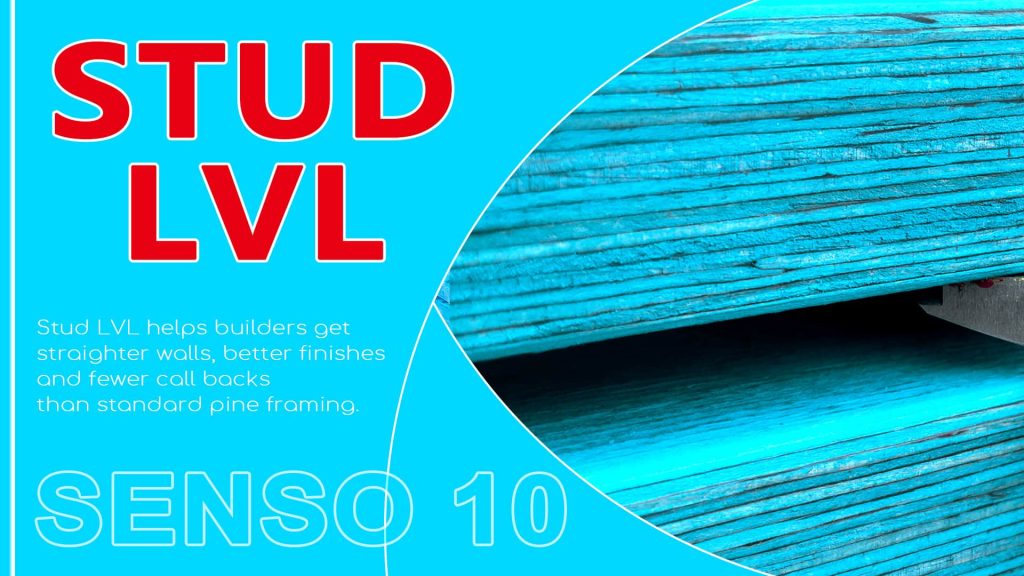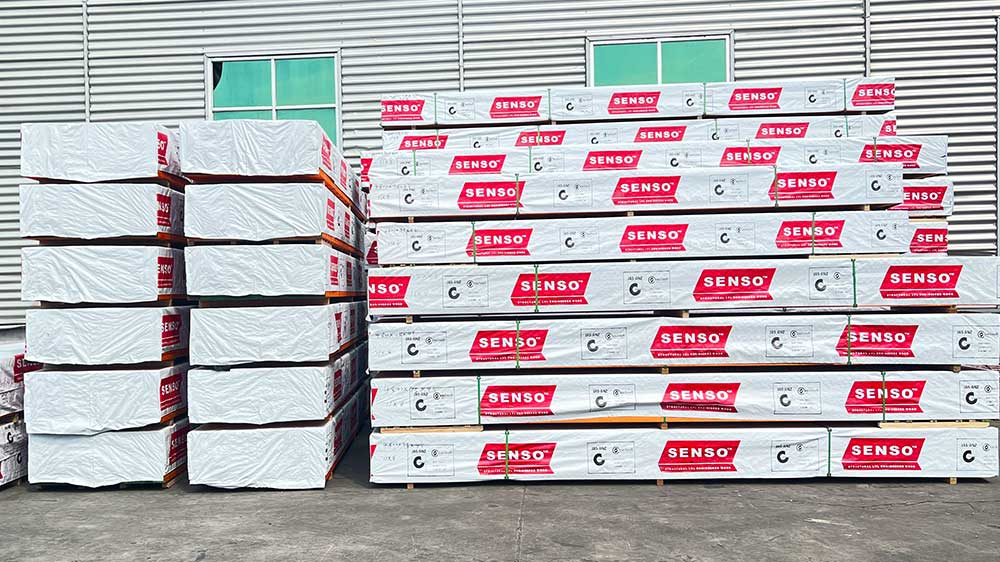Stud LVL 10 versus MGP10 and MGP12 pine framing
Framing choices affect cost, finish and future call backs. On most projects today, builders balance Stud LVL 10 against familiar MGP10 pine framing and MGP12 structural pine. All three options can satisfy code, but they behave very differently on site and over the life of the building.
As a manufacturer of SENSO Stud LVL 10, we see this decision every day. Wholesalers want stock that moves quickly and keeps customers loyal. Site crews want studs that stay straight and predictable. Owners want clean lines, flat walls and doors that keep swinging smoothly for years. The right stud choice helps every group reach those goals.

What is Stud LVL and how does it differ from pine?
Stud LVL belongs to the laminated veneer lumber family. Thin wood veneers glue together under heat and pressure to form a single, stable section. This build spreads natural defects, gives uniform density and produces consistent strength and stiffness along the full length. Engineered wood studs gain much of their value from that consistency.
Pine framing works in a simpler way. Each stud comes from one solid piece of timber with its own knots, grain slope and checks. Machine grading groups pieces into MGP10 pine framing or MGP12 structural pine, yet variation still lives inside each pack. Some studs stay straight. Others twist, bow or cup as they dry or as site conditions change.
Engineered sections like Stud LVL reduce that guesswork. Veneers dry to tight targets before pressing. Glue lines lock everything together, so internal stresses spread across many layers. The result is a stud that resists warping and keeps its shape more reliably than many solid boards. You see that difference most clearly after the walls stand, linings go on and finishes meet the frame.
Strength and stiffness: Stud LVL versus pine
Strength and stiffness sit at the core of this comparison. LVL studs generally use design values that match or exceed common pine framing grades of the same size. That higher and more consistent stiffness limits wall deflection, especially in tall spaces, around wide windows or under heavier roof loads.
MGP10 pine framing provides an affordable base for general housing work. It offers enough strength for most single storey walls and many standard spans. MGP12 structural pine lifts that capacity one step and suits heavier loads or longer spans where extra safety margin helps. However, both grades still reflect the natural spread of properties within each group, so one stud can feel stronger or stiffer than the next.
Stud LVL aims for tighter performance bands. Many thin veneers blend into one stable block, so a knot or small defect in any single layer has far less impact on the final section. Designers can rely on the numbers with more confidence. On site, walls feel quieter and more solid, and sensitive finishes such as tiles or long plaster runs suffer less movement over time.
SENSO Stud LVL 10 follows this engineered approach. We target high stiffness to support modern layouts with taller walls, larger openings and heavier cladding. That support allows efficient stud sizes without sacrificing comfort, code compliance or structural safety.
Wall straightness and finish quality
Ask any plasterer or cabinet installer what they value most and “straight walls” appears near the top of the list. Stud LVL helps deliver that result. Because the section stays dimensionally stable, it resists twist, bow and cup from pack to finished frame.
Straight framing transforms the finish. Bathroom tiles sit flatter with fewer lippage issues. Kitchen cabinets and benchtops need fewer packers behind the carcass. Long hallways paint out with cleaner lines and show fewer waves under light. These details influence how owners judge quality and how many adjustment visits a builder needs to make after handover.
Solid pine can also produce straight walls, but usually with more work. Crews often sort packs, put the better pieces into feature walls and push weaker sticks into short studs or blocking. They may spend extra time pulling frames into line and packing studs before linings go on. That labour cost grows quickly when skilled people are in short supply and site schedules are tight.
Because Stud LVL stays closer to line, site teams keep a smoother rhythm. They stand frames, brace once and move on instead of revisiting problem walls. SENSO Stud LVL 10 also offers precise dimensions and clean arris edges, which makes fixing faster and easier for follow-on trades.
Cost, waste and productivity on real jobs
On paper, pine often looks cheaper per metre. Stud LVL sometimes sits higher on the price list. Builders who work with both materials know the real story is more complex. They focus on installed cost, not just material price.
Waste is the first hidden cost. Packs of engineered wood studs usually contain far fewer rejects. Crews cut around fewer big knots or badly twisted pieces, so more of each length ends up in the frame. Over a full house or a run of townhouses, that difference adds up in both offcut volume and disposal fees.
Labour is the second factor. With straighter studs, carpenters spend less time straightening walls or packing them before linings. Plasterers and tilers also move faster on flatter backgrounds. Every saved hour reduces pressure on busy crews and frees them to start the next job sooner.
Rework forms the third part of the cost picture. Call backs for cracked tiles, uneven paint lines or doors that bind all eat into margin. By holding alignment and stiffness over time, Stud LVL lowers the risk of those problems. For wholesalers, SENSO Stud LVL 10 becomes an easy “upgrade” line in the stud rack. It supports a higher average invoice value while still delivering clear benefits to builders and owners.

Durability, moisture behaviour and termite protection
Moisture changes drive many framing issues. When timber takes up water and then dries out, it can shrink, swell and move. That movement opens joints, stresses finishes and can even affect structural performance over many years.
Stud LVL handles these cycles better than many solid studs. Veneers dry and condition before pressing. Adhesive bonds them into a block that responds in a more controlled way. Walls framed with engineered wood studs often hold joints more tightly and keep fixings more secure, especially around wet areas such as bathrooms and laundries.
Termite risk also shapes framing choices in many regions. Both pine framing and LVL studs can receive treatments that match local hazard classes. MGP 10 pine framing and MGP12 structural pine often appear in termite-resistant versions. Engineered studs follow the same pattern, so yards can stock treated Stud LVL beside treated pine and offer equivalent protection at different performance levels.
SENSO Stud LVL 10 aligns with those expectations. We offer treated options designed to match common regional requirements, which keeps specification simple for engineers and builders and keeps stock management simple for merchants.
Design freedom, tall walls and mixed systems
Modern homes increasingly use high ceilings, wide glazing and heavy finishes. These features place more demand on studs than simple single storey boxes. Engineered studs such as SENSO Stud LVL 10 handle those demands well.
Higher and more reliable stiffness keeps tall walls feeling solid and reduces the chance of visible deflection under load. That matters in double height entries, stair voids and large living spaces with big window openings. Stronger studs also support heavy cladding, stone features and large format tiles that need a very stable backing.
Stud LVL also works neatly with other LVL elements. Designers can combine LVL studs, LVL beams and LVL joists to create a fully engineered frame. This approach simplifies load paths, supports clear detailing and reduces the number of different section types needed on site.
SENSO Stud LVL 10 fits this system thinking. We match stud sizes to common LVL beam and joist dimensions so the frame looks and behaves like one integrated package. For wholesalers, that makes it easier to sell full engineered solutions rather than just individual items.
When MGP10 or MGP12 pine framing still makes sense
Pine still has a strong role in structural framing. Many projects run perfectly well with MGP10 pine framing in low, lightly loaded walls. For simple, price-driven builds, MGP 10 offers a familiar, proven and efficient choice.
MGP12 structural pine provides the next step. It gives extra capacity for longer spans or heavier loads without changing the basic framing system. Builders who have used pine for many years know how it behaves and how to detail connections and fixings.
On some jobs, supply and timing may favour pine. If a yard carries large volumes of treated MGP10 and MGP 12 in key sizes, and Stud LVL needs a short lead time, crews may choose pine to keep schedules on track. That flexibility matters in fast housing estates and in regions with limited storage space.
Even so, many contractors now blend materials on the same job. They frame standard internal walls in pine and reserve SENSO Stud LVL 10 for bathrooms, kitchens, feature corridors and shear walls. This mixed approach keeps budgets under control while lifting performance and finish quality in critical areas.

How SENSO Stud LVL 10 supports wholesalers and builders
Wholesalers need clear stories they can share with busy customers. The LVL stud category makes that easy because the benefits are very practical. SENSO Stud LVL 10 slots naturally as the premium option above standard pine.
Merchants can position it as the first choice for cabinet walls, tiled shower walls, long feature halls and heavy façade zones. These use cases highlight the value of straighter framing, higher stiffness and better long-term stability. They also give sales staff simple prompts when they review plans or walk a yard with builders.
From an inventory point of view, Stud LVL extends the framing ladder. Entry level work can stay with MGP10 pine framing. Mid-range projects may use MGP12 structural pine in selected locations. Higher performance or design-driven builds then move to SENSO Stud LVL 10 as the natural upgrade. This structure keeps customers within one supplier’s range instead of pushing them to a competitor for engineered options.
As a manufacturer, we back the product with technical data, training support and marketing material that focus on real job results. We help explain how straighter walls reduce call backs, how stiffer frames carry heavy finishes and how engineered wood studs fit within current codes and design practice. That support builds confidence and repeat orders across the whole supply chain.
Making the right framing choice
There is no single answer for every frame. The best choice between Stud LVL, MGP10 pine framing and MGP12 structural pine depends on wall height, loads, finish level, labour cost and client expectations. Still, a simple rule now guides many projects.
Use pine when geometry stays simple and budgets sit under heavy pressure. Step up to Stud LVL where walls carry important finishes, heavy loads or high visual impact. In practice, that often means choosing SENSO Stud LVL 10 for tiled bathrooms, kitchen runs, entrances, stair voids and long external walls with large windows.
This approach lets builders and wholesalers offer clear options instead of one compromise line. Owners gain straighter walls, smoother finishes and fewer long-term issues. Merchants lift average sale value and deepen relationships with key customers. With SENSO Stud LVL 10 in the rack, every project can match its framing system to its real performance needs, not just to the lowest upfront price.

LVL Timber
In the realm of commercial construction, structural integrity is paramount. SENSO Laminated Veneer Lumber (LVL) beams, recognized for their superior strength and durability, play a significant role in building robust structures that withstand the test of time.
Unveiling SENSO LVL Timber
SENSO LVL Timber are crafted with meticulous precision, harnessing the strength of laminated wood. These beams, renowned for their structural features like cross-orientation, superior strength, stiffness, and dimensional stability, redefine construction standards.
SENSO LVL Advantages in Commercial Construction
ROCPLY LVL Beam bring multiple benefits to commercial construction:
- Superior Strength and Stability: SENSO LVL Timber ensure buildings are robust, long-lasting, and resilient.
- Flexibility and Customization: Our LVL Beams can be tailored to suit diverse construction requirements.
- Cost-Effectiveness: SENSO strikes the perfect balance between quality and affordability.
- Sustainability: We uphold green practices, ensuring our products are environmentally friendly.
- Moisture and Fire Resistance: SENSO Structural LVL are designed to resist moisture and fire, enhancing safety.
- Variety and Aesthetic Appeal: We offer a range of sizes and decorative options, catering to various aesthetic needs.
Adherence to Industry Standards
SENSO commitment to quality shines through in our adherence to strict JAS-ANZ standards. Our laminated wood LVL surpass these standards, reinforcing our commitment to delivering high-performance and reliable products.
LVL Timber: Enhancing Structural Integrity
SENSO LVL Beams are vital to maintaining a building’s structural integrity. With outstanding load-bearing capacity, shear strength, dimensional stability, and resistance to humidity, our LVL Beam uphold the structural rigidity of buildings, meeting diverse architectural demands.
Diverse Industries and Applications
SENSO LVL Timber are embraced across numerous industries, including commercial construction, interior design, furniture manufacturing, and many more. The superior quality and versatility of our products make them the first choice for various applications.
Choose SENSO LVL Timber
ROCPLY LVL Beam are a testament to our unwavering commitment to quality, performance, and sustainability. They enhance the structural integrity of commercial buildings while catering to diverse architectural needs. Discover more about SENSO range of LVL timber products, connect with our sales team, or make your purchase today – we’re ready to redefine your construction experience.
Post time: Nov-24-2025

